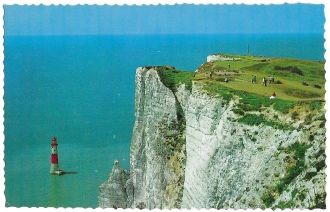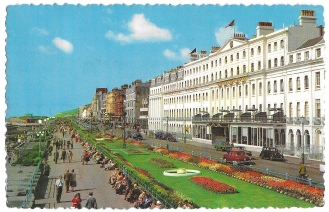
As the Second World War loomed, Wiseman Horner
decided to abandon postcard production. Etheridge
acquired the negatives and started re-
some of the cards under the Shoesmith & Etheridge label.
Possibly, he also took over production of some
sepia-
other places in Sussex that Nigh of Ventnor in the Isle of Wight had been publishing.
The Second World War brought difficult trading conditions, but unlike many other postcard publishers Etheridge managed to keep production going.
During WW2 Shoesmith & Etheridge cards underwent another redesign. The Norman badge
and scroll reappeared; this time flanked by the words "POST" and "CARD" written in
tapered hollowed-
"This happy breed of men, this little world,
This precious
stone set in a silver sea".
A machine to provide postcards with a deckle edge was purchased, so that the work could be done in house. Those postcards were prefixed with the letter “D” or “N”, but confusingly not all postcards with a deckle edge had these prefix letters!
With the return of peace, Etheridge, helped by his son-
The final design of back, which was introduced in July 1953 used a redrawn Norman head enclosed in a circle. Five variants have been seen (Type 5). In the mid 1950’s cards began appearing with backs printed in blue instead of familiar black.
In 1956 the firm was still located at 153 and 154 Queens Road. At about this date six "Norman Series" cards of Winchelsea with facsimile pencil sketches in place of photographs were put on sale for 1/6 a set, but they seem not to have been very popular.
By 1962 Etheridge and his son-
Unfortunately, all the modernising efforts proved in vain because the market for postcards continued to contract, and in about 1966 the painful decision was made to end postcard production. The firm of D. V. Bennett of Maidstone purchased the negatives and the remaining stock of postcards. For some years they continued to issue cards with the Norman logo but under the Bennett name.
Although no longer publishing cards, Shoesmith and Etheridge were still in business, based in Uckfield, producing stationery, wrapping paper and other items. In 1992 the firm was acquired by Johnston Press plc, an Edinburgh firm, which publishes over 200 local newspapers. However, in 2018 Johnston themselves went into administration, and S&E disappeared for the last time.
In their heyday as postcard publishers, Shoesmith and Etheridge served a large area of coastal Kent, Sussex, Hampshire (though not the Isle of Wight) and Dorset, to varying distances inland (for example, to Maidstone, Canterbury and Lewes). All in all, they may have issued over 2000 cards of Sussex. Few of the photographs are really inspiring, and too many are of rather mundane subjects, such as the unlovely bungalow sprawls at Camber and Peacehaven. Nevertheless, the cards provide many useful glimpses of the past.
Albert Shoesmith, who had been living at 65 Downs Road in Hastings, died in St Leonards on November 16, 1957, aged 81. He left effects of £4014. Serena Etheridge passed away in June 1975, but her husband George lived on in retirement at Sussex House, 110 Marina Street, St Leonards until April 12, 1980, when he suffered a fatal cerebral thrombosis.



Shoesmith and Etheridge
S&E Page 6 of 12